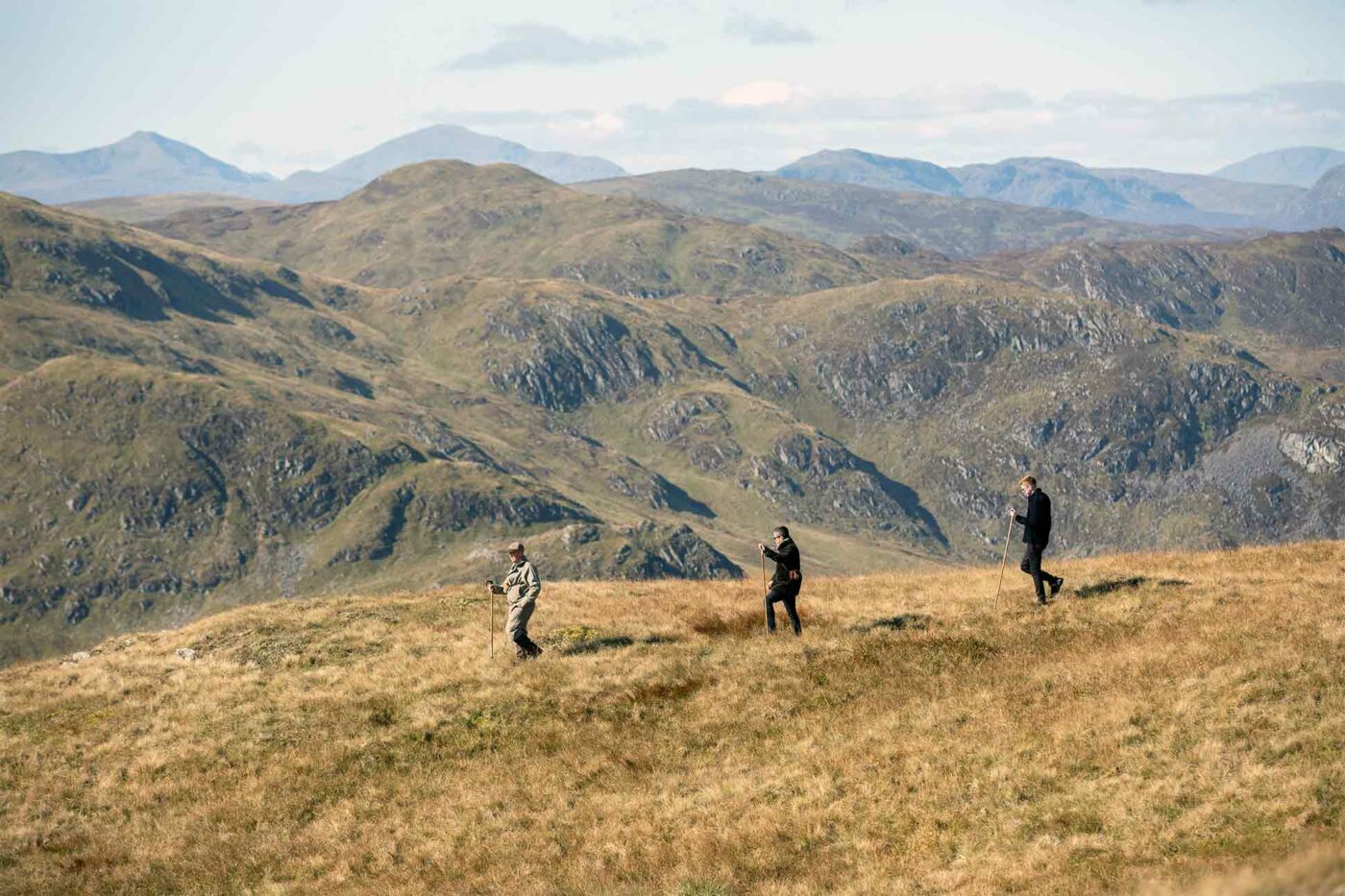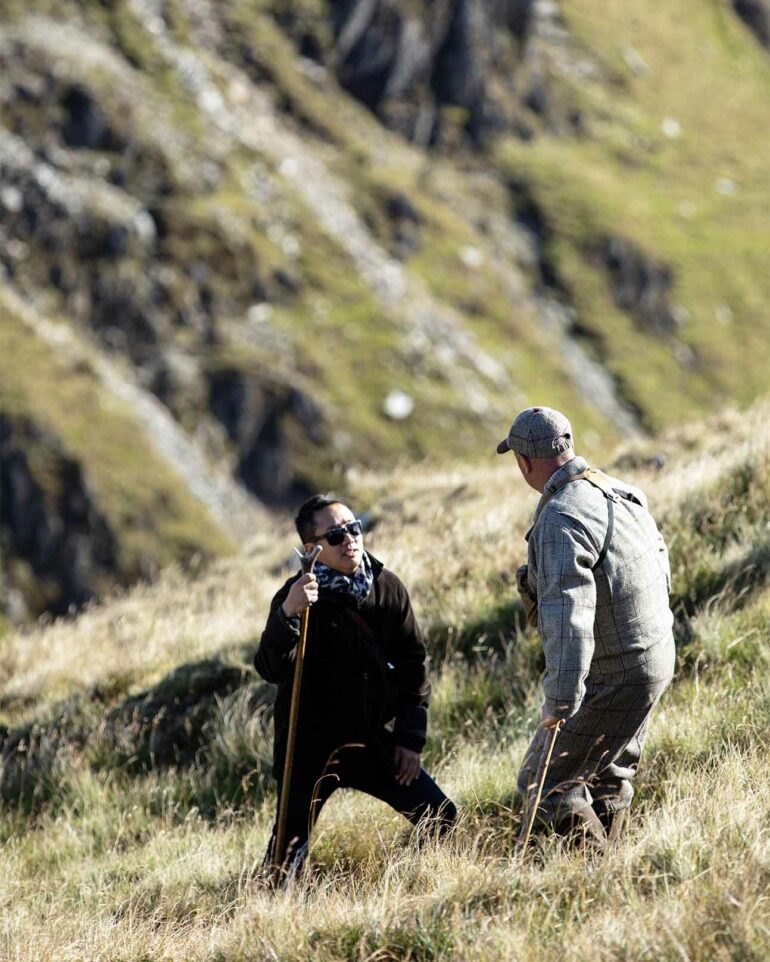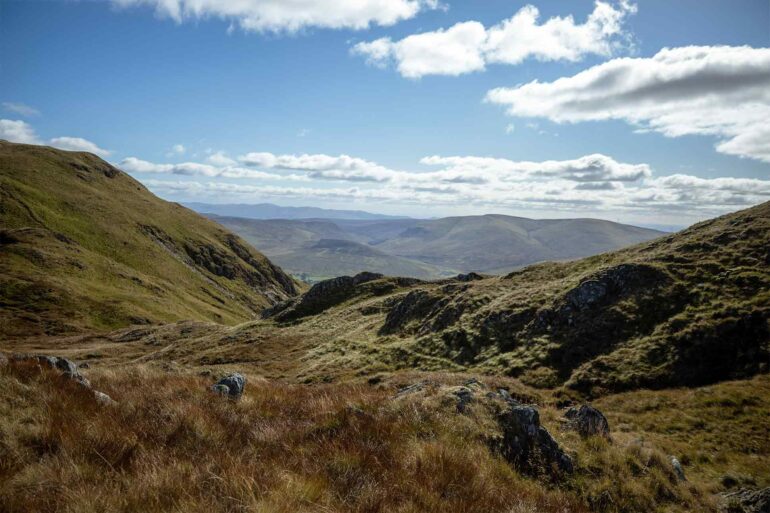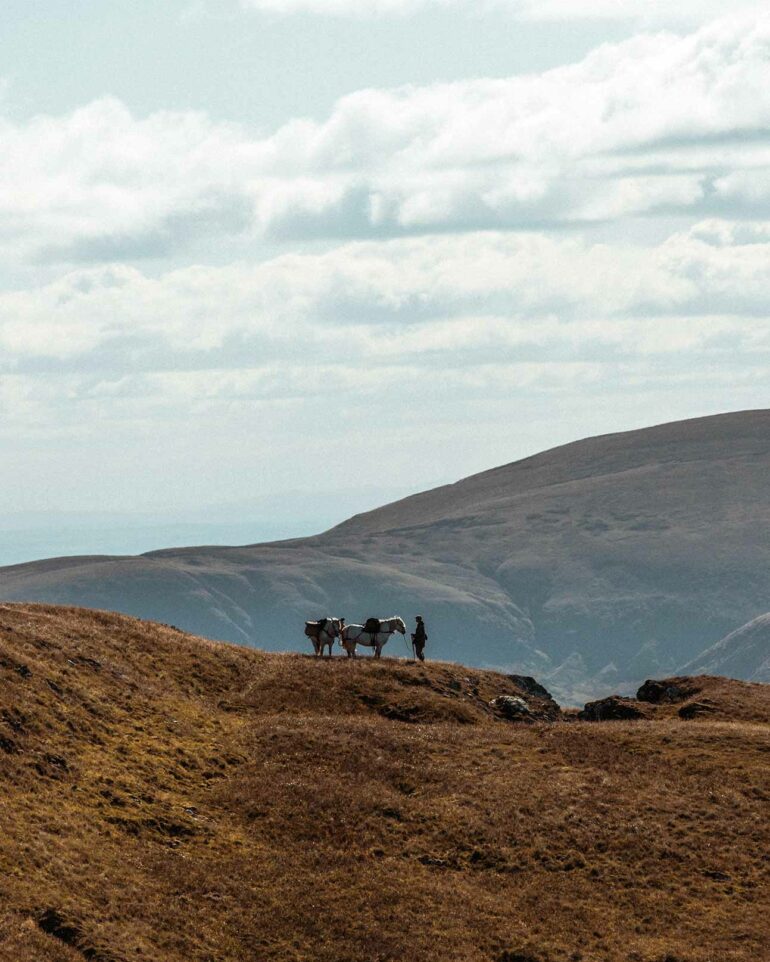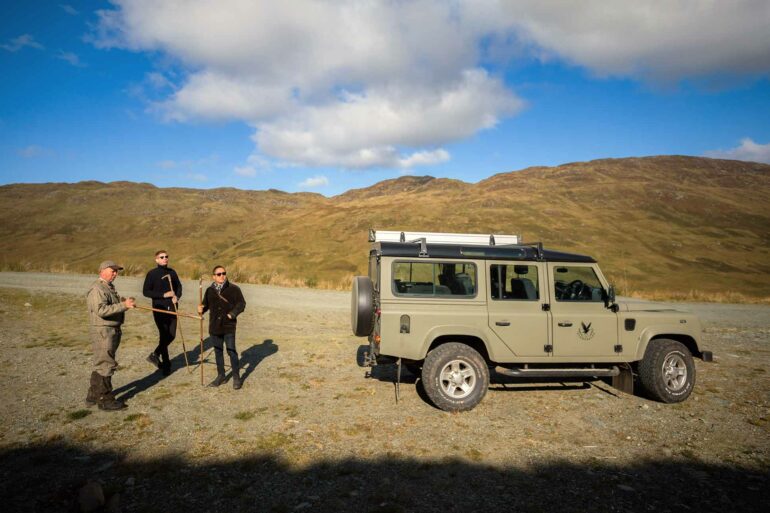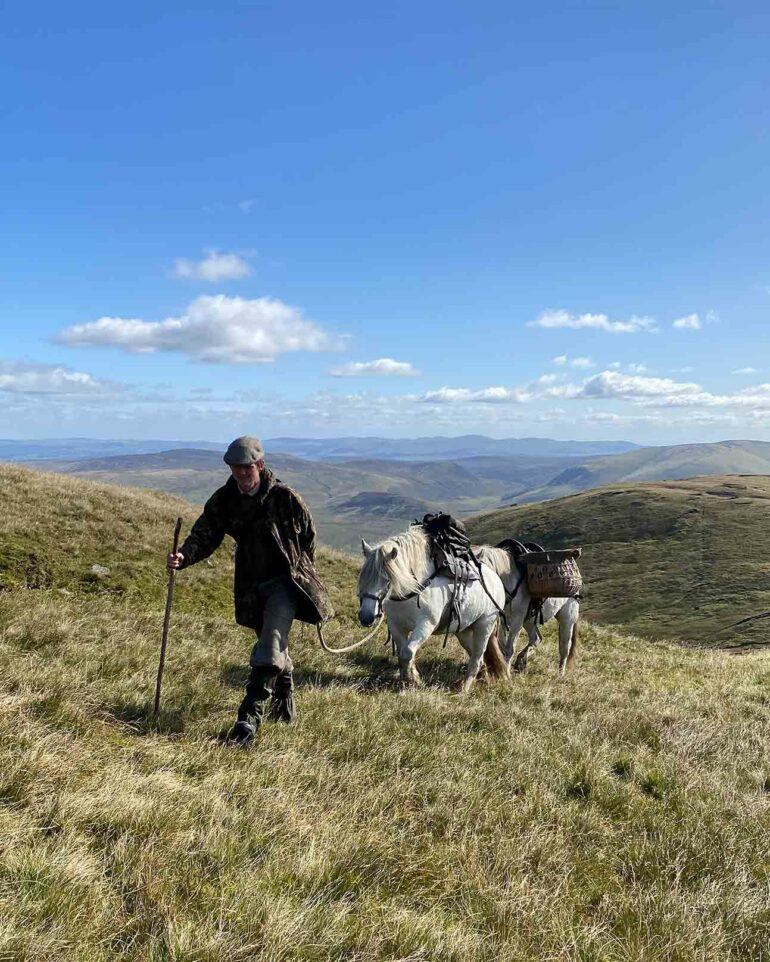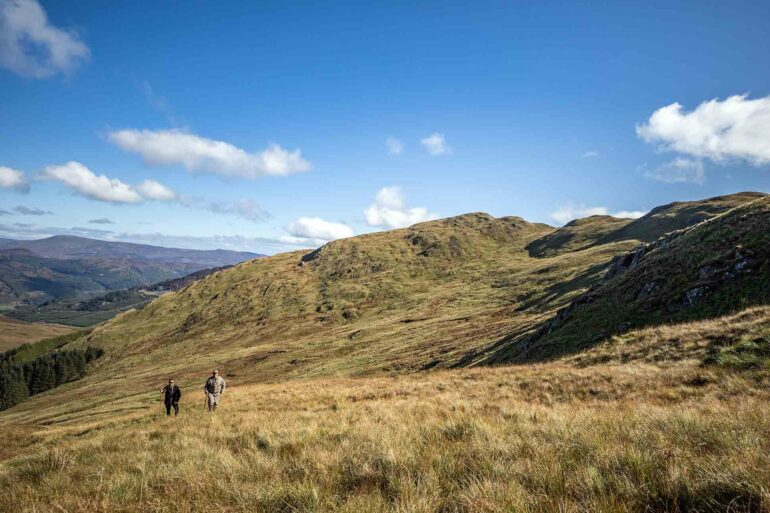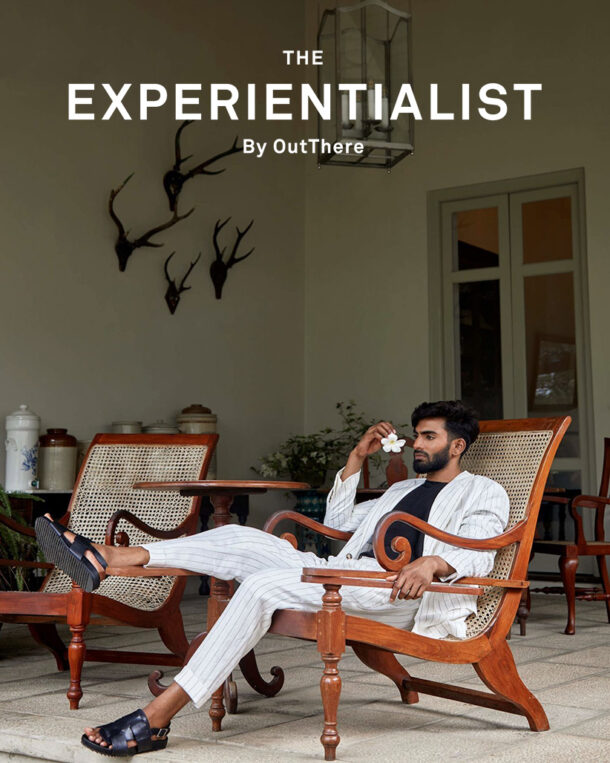Gleneagles in Auchterarder may be best known for its golf, but it’s also within easy reach of the historic deer forest and rugged hills around Loch Earn. We take a walk in Glen Artney, bag our first Munro, enjoy a thrilling brush with some deer, and discover stories of royalty, conservation and experiential luxury.
Standing by his moss-coloured Land Rover Defender (the cleanest, most impeccable off-roader that I’ve ever seen) is Yuri Janssen, Gleneagles’ country sports manager, dressed in characterful country gear: tweed shooting breeks with boot socks pulled over them, checked shirt, a creaseless Gleneagles branded teal fleece and Baker Boy cap, perched perfectly on his head, somewhat tilted like an army-man’s beret.
He greets us with a big smile; looks us up and down and sends us back to our room to change. It seems us city-slickers may have misinterpreted what today’s ‘walk’ would be. Having spent a couple of days in the self-billed ‘glorious playground’ of luxury that is Gleneagles has clearly lulled us into a false sense that ‘outdoor pursuits’ involve frolicking with packs of gundogs, falconry or trying our hand at clay pigeon shooting.
Gleneagles is a refined, destination resort. For those who golf, its reputation precedes it, but beyond its sporting renown, it’s a legendary Scottish getaway with an over-a-century-old reputation – fully modernised to world-class standards. It’s an effortlessly experiential hotel, with exemplary service by a hand-picked team. It boasts incredible cuisine in its many restaurants and has an air of glamorous jazz-aged-reminiscent sociality with lashings of informal fun, particularly after a few signature cocktails in its American Bar.

This story first appeared in The Experientialist Issue, available in print and digital.
Subscribe today or purchase a back copy via our online shop.
Returning from our Braid House suite, fully prepared to stay warm, dry and looking far less ‘London’, we set off on the road to Glen Artney, 45 minutes away. It’s the sunniest of Scottish days, but Yuri explains that where we’re going, things can change in a heartbeat. We’re headed to the Drummond Estate, a unique partnership carved out by the hotel with one of Scotland’s most storied grounds, an ancient royal deer forest steeped in history, today owned by the 28th Baroness Willoughby de Eresby – or “Lady Willoughby” – as Yuri affectionally calls her.
Around us, a rugged landscape unfurls theatrically. We descend into the glen of ancient moorland, flanked either side by high hills peppered with heather and juniper; turfed, giant ramps – bright yellow because of a long summer – leading up to a crisp, blue sky.
En route, we pick up another charmingly dressed man, Alistair – head-to-toe in Scottish slate-grey plaid, complete with matching cap and face-mask – the estate manager at Drummond. It’s an honour for us tourists to spend the day with Alistair, as he is usually kept busy running the 60,000-acre estate (seventy times the size of the sprawling grounds of Gleneagles) and more importantly, stalking deer.
We abandon the vehicle and kit-up for a hike that will take us to the peak of the monolithic hill we see before us. The trepidation of the ascent sets in, as does the cool glen wind, blasting away any warmth we may have felt from the bright sunshine. We’re glad Yuri made us change.
Glen Artney spans thousands of acres of ancient ‘forest’ (hunting grounds), with dramatic, undulating landscapes affording views of lochs and Munros.
“The hardest bit is getting up there,” Alistair pipes as if we didn’t already know. He trudges uphill to set the pace, but ten minutes in, we’re already struggling to catch our breath. Considerately, Alistair stops regularly, pulling out his binoculars to survey the landscape for deer, an exaggerated move to politely allow us to catch up. Each step has us sinking into tussocks of yellow grass and cushions of green sedge, but this doesn’t afford any relief to our burning thighs. “Every day is leg-day,” Alistair jests as he starts to tell us the story of the area’s history.
Glen Artney is considered one of Scotland’s finest examples of royal deer forest. The term ‘forest’ is used loosely because there aren’t any natural woods in sight. In old English, a forest is a large area of land, set apart by a royal edict for wild beasts and fowls of chase, the ‘glorious playground’ of its day. It dates back to the time of King James I and was the favourite hunting ground of Mary Queen of Scots and other Stuarts before her.
Alistair recites a stanza from Sir Walter Scott’s The Lady of the Lake in his charming Scottish brogue: “The stag at eve had drunk his fill, Where danced the moon on Monan’s rill, And deep his midnight lair had made, In lone Glen Artney’s hazel shade.” Beyond its literary significance, the verse helps Alistair segue into the topic of deer management. He cleverly senses our discomfort on the subject of hunting and proceeds to give us the low down.
Stalking is about maintaining the numbers, health and genetic integrity of the stock of native, wild red deer – an age-old tradition, generally misinterpreted for sport. There is of course a pleasure-driven motivation for shooting deer, but its roots lie in a long history of conservation. While it seems counter-intuitive – that to preserve the ecology, you have to cull some of it – it’s done for good reason and more so under the instruction of the Scottish government.
For the longest time, sheep farming and agriculture were the lifeblood of this expansive area (not the most ecologically sound of practices, as it affected the natural flora and led to predators like wolves being wiped out here). But the impact of human existence meant that the deer population was controlled. With industrialisation, farming became untenable and a lot of the land was returned to the wild. With that came an unprecedented boom in deer numbers, particularly over the past 50 years. In the early days, the landowners saw this as a burgeoning economy. The more shootable deer you had on your land, the more money your estate was worth. Red deer populations were encouraged to flourish; the hype is said to be the reason why the stag is held up as a symbol of Scotland’s greatness. But deer – much like sheep – feast on leafy saplings and tree bark. Young bucks slash flora when they’re ridding their antlers of velvet. There are an estimated 750,000 wild deer in Scotland. As food grows increasingly scarce, they are forced down the glen and into croplands and gardens. They run into roads, causing accidents: around 9,000 deer-related traffic collisions a year.
As we reach the top, our legs and lungs relieved, the magic of Glen Artney reveals itself with breathtaking views as far as the eye can see. Lofty mountains (or Beinns in Gaelic), rise up eerily, some standing guard
over the glen and lochs, others kneeling like loyal knights over the ridge of Ben Vorlich that we’re stood on. The views are awe-inspiring in every direction and the sun up here is warming – the air, fresh and glorious. Our first Munro – bagged.
This is when Alistair tells us that we’re walking in the footsteps of generations of royalty, including Queen Victoria who visited in 1842.
“Her husband, Prince Albert, shot his first Scottish stag here.” Alistair points his walking stick down the valley as if to geolocate the exact spot. I wouldn’t put it past him to know.
The royal connection comes from land gifted back in the 14th century. Somewhere on this expansive estate that is home to Glen Artney is Drummond Castle, a 17th-century stately home with landscaped gardens, built around the same time as those in Versailles. A tempestuous, Scottish-English drama followed and the land forfeited to the state. But the Drummonds came back into favour in the late 18th century, buying it all back and returning it to its noble splendour, which brings us back to Victorian times and the eponymous Queen’s visit. The royal link continues until this day. Lady Willoughby was one of Queen Elizabeth II’s maids of honour; and holds a quarter stake in the Office of the Lord Chamberlain. The blue-blood runs thick.
Walking the land, the wealth and privilege of the family dawns on us. It is important to recognise that much of the British upper-classes have benefitted from an inheritance that encompasses wealth generated in the era of slavery. Scottish historians corroborate that its gentry had links to the exploitative Caribbean sugar trade and were compensated after emancipation. It’s not clear if the Drummond-Willoughbys were complicit. The estate was established long before Scottish capitalists began slave trading. But between the 17th and 19th centuries, it was unlikely that any family of means were innocent of involvement. Digging deeper, there are some historical notices of family members speaking out in support of abolition, but there were also some that were rather against it.
Our train of thought is broken by the arrival of Jack, one of Alistair’s assistants, alongside two sturdy, white Garron ponies. They’re impressive beasts, often called ‘Highland ponies’. On their backs are picnic baskets with lunch from Gleneagles’ kitchen. Yuri hands us a hip flask of whisky. A couple of swigs in, all is good in the world.
It’s hard to get enough of the view from up here, but the other side of the mountain is equally enchanting. It’s wet underfoot as we descend the gentler slope, dotted with heather and rushes, riven with little brooks and burns. It’s a pleasure to experience this nature at its wildest, particularly in an age where we’re hungrier than ever for open space. There’s great beauty in the seemingly deserted landscape. It’s easy to think of Britain as a green and pleasant land of thick oaks and grassy meadows, but out here in the windswept wilds of Glen Artney, the boggy moorlands are what catches the eye.
Suddenly from nowhere, a herd of deer darts across the landscape. These majestic denizens of the Beinn appear so resplendently, it catches Yuri off-guard. He was so busy photographing us ambling down the mountainside, that he missed getting a shot of the herd, running so close to us that we could see the rich red of their glistening coats. You’ll just have to take our word for it. We’re told that we are blessed – most guests would only see them from a distance through a pair of binoculars, or through the gunsight of a rifle.
We’re lucky in that we get to visit many experiential hotels like Gleneagles, but the ability to step away from ‘organised fun’ and truly appreciate the beauty of Scotland’s wild nature is something that sets the whole experience apart. Add to that the chance to return after a day of adventuring into unadulterated luxury, including some pampering in the property’s five-star spa… that’s the kind of adventure we adore.
Photography Yuri Janssen


